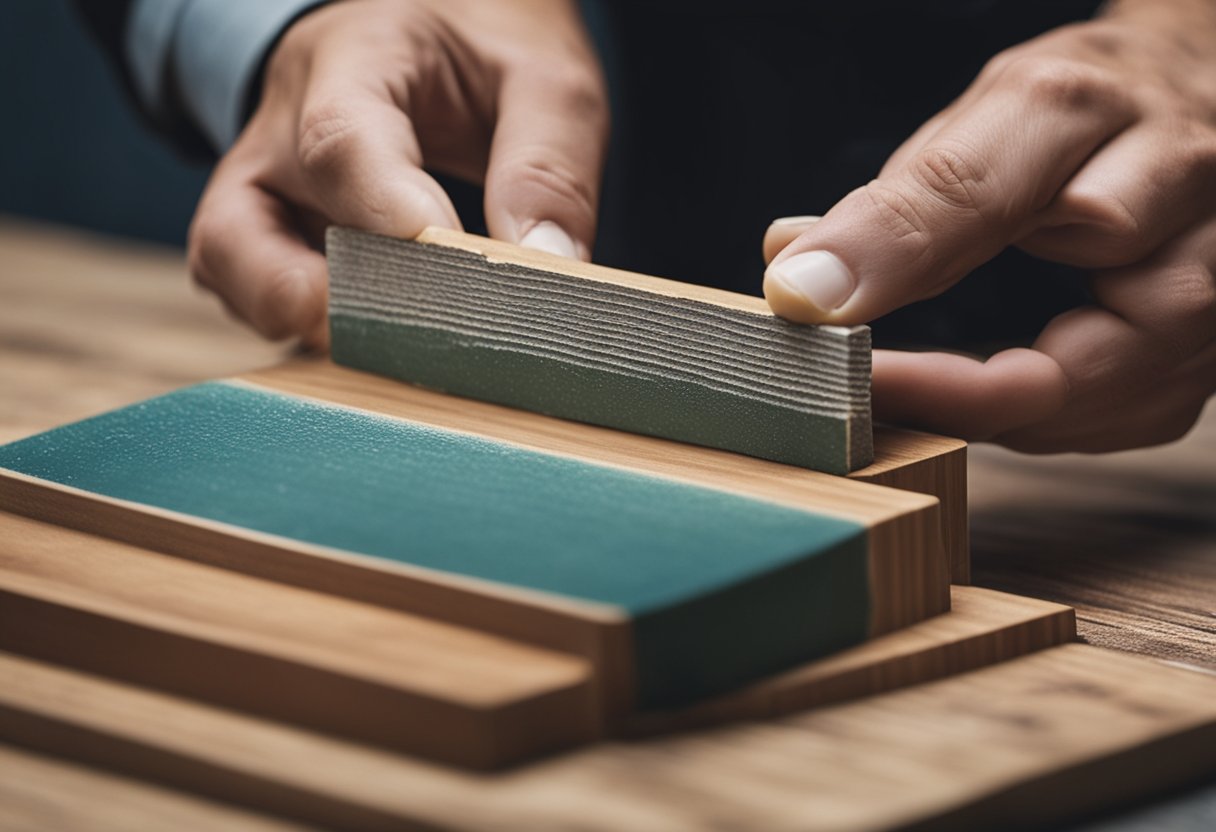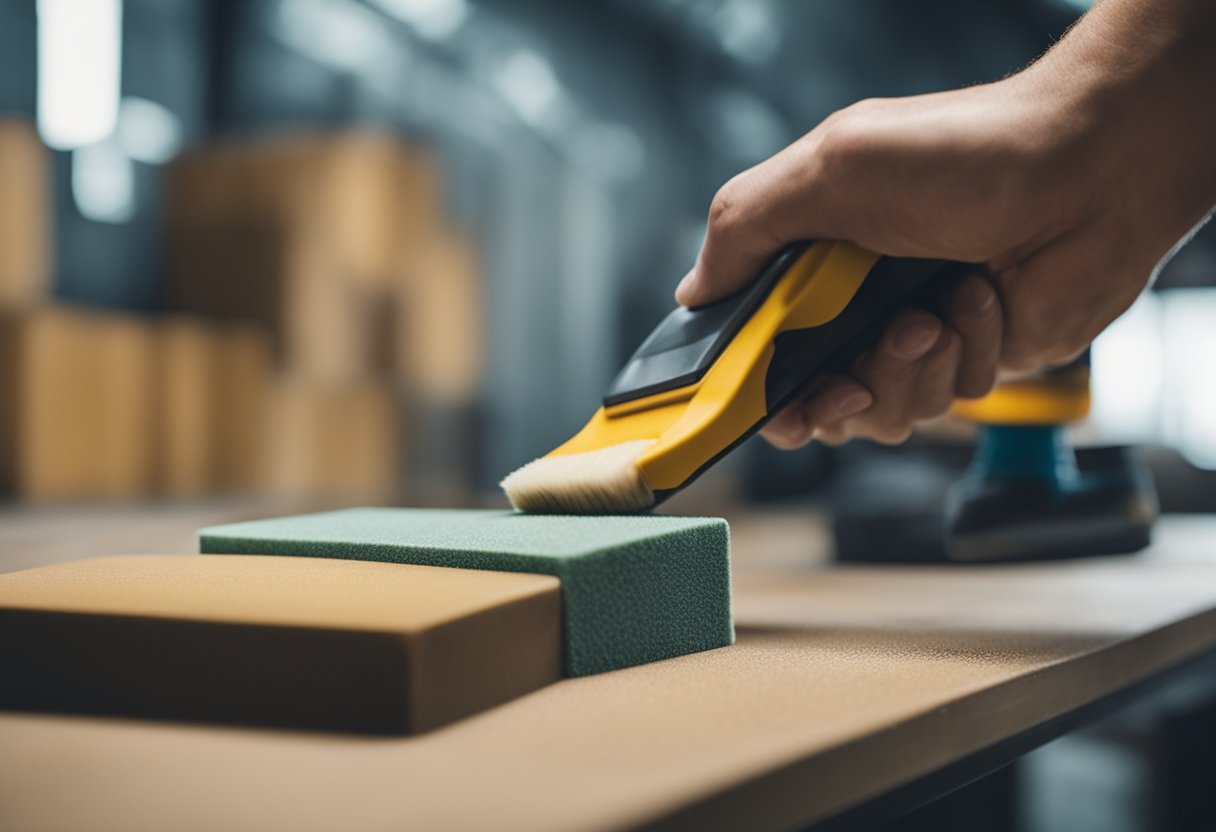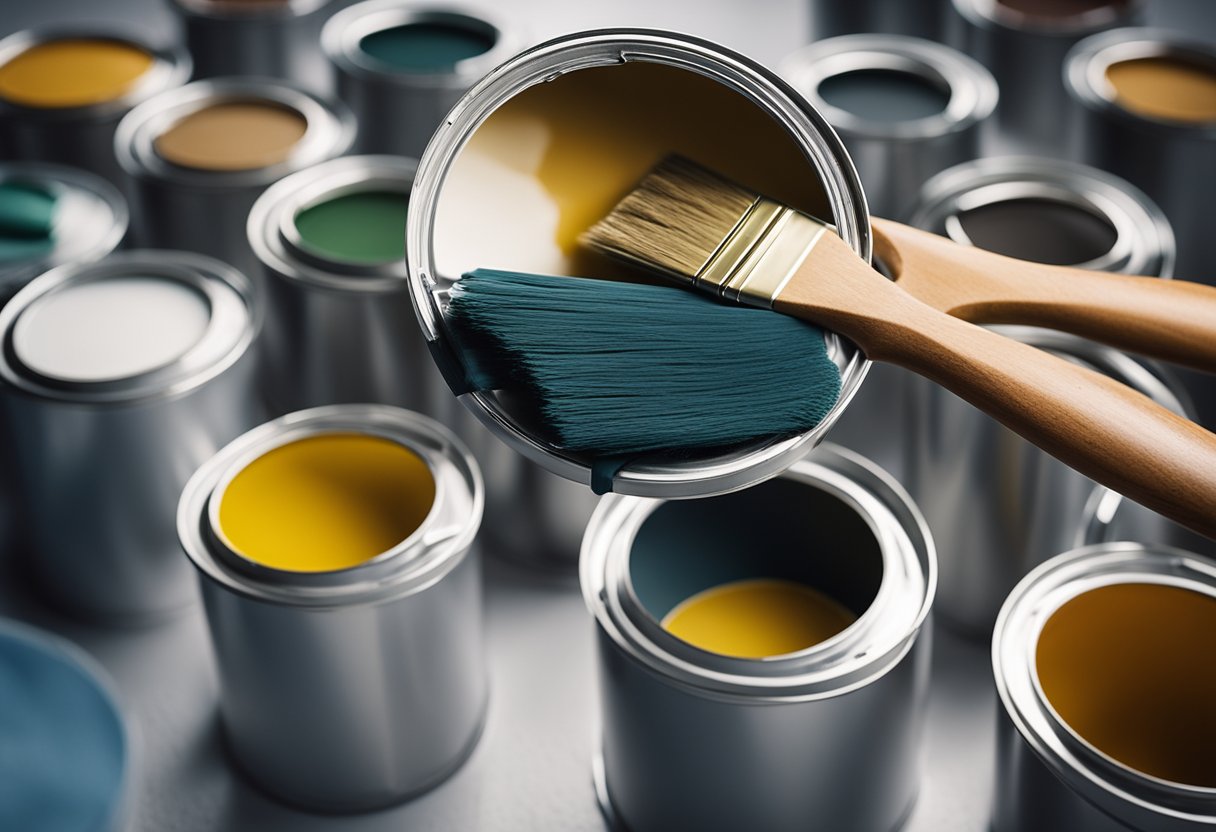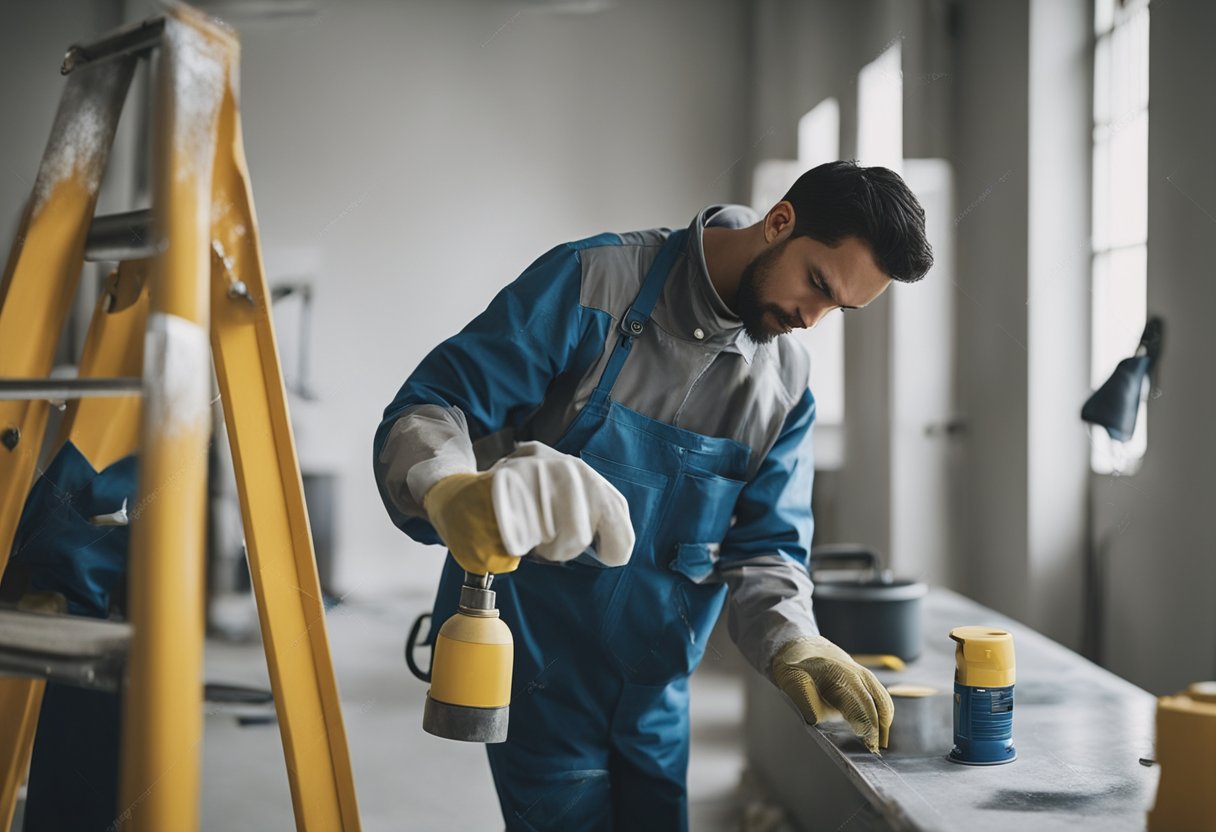When it comes to painting a room or furniture, sanding between coats of paint is a common practice. But is it really necessary? The answer is yes, sanding between coats of paint is recommended for a smooth and even finish. This is the only distinction between an excellent coat of paint and one that falls short.

Sanding between layers of paint is particularly important when using high-gloss or semi-gloss paints, as these types of paints tend to show imperfections more easily. It’s also essential when painting over surfaces that have been repaired or have imperfections, as sanding helps to smooth out the surface. However, sanding between coats of paint isn’t always essential, and it depends on the type of paint and the surface being painted.
In general, sanding between coats of paint is a crucial step in the painting process that should not be skipped. It helps to ensure a smooth and even finish, and it’s particularly important when using high-gloss or semi-gloss paints or painting over surfaces that have been repaired.
Understanding the Painting Process
As a professional painter, I understand the importance of proper preparation before starting any painting project. One of the most crucial steps in achieving a smooth and even paint job is sanding between coats of paint. Sanding helps to create a uniform surface by removing any rough spots or imperfections, allowing the subsequent coat of paint to adhere properly.
Before starting any painting project, it’s essential to choose the right kind of paint. There are various types of paints available in the market, such as latex paint, oil-based paint, water-based paints, chalk paint, and many more. Each type of paint has its unique characteristics, such as drying times, durability, and finish.
The finish of the paint is also an important consideration when choosing the right kind of paint. There are several finishes available, such as high gloss paint, semi-gloss, matte, flat paint, and glossy paint. The finish of the paint can affect the overall appearance of the painted surface, so it’s essential to choose the right one for your painting project.
Once you have chosen the right kind of paint, it’s time to start the painting process. The first step is to prepare the surface by cleaning and priming it. Primer coats are essential for creating a smooth surface and ensuring that the paint adheres properly.
If you are working with an old paint job, it’s crucial to remove any peeling paint and sand the surface before applying a new coat of paint. Sanding between coats of paint is also essential to ensure that the subsequent coat adheres properly and creates a smooth surface.
Drying times and humidity levels can also affect the painting process. It’s essential to follow the manufacturer’s instructions regarding drying times and to avoid painting in high humidity conditions.
In conclusion, sanding between coats of paint is an essential step in achieving a smooth and even paint job. Choosing the right kind of paint, primer coats, and finishes are also crucial considerations in the painting process. Proper preparation and attention to detail can make all the difference in achieving a professional-looking paint job.
Why Sand Between Coats of Paint
As a professional painter, I always recommend sanding between coats of paint. It’s a crucial step that can make a significant difference in the final result of your paint job. Sanding between coats of paint is essential for achieving a smooth surface and ensuring that the subsequent layers of paint adhere correctly to the surface.
When you sand between coats, you remove any imperfections, brush marks, bubbles, and scratches that may have occurred during the previous coat. Sanding also helps to remove any paint build-up, which can result in a rough surface and an uneven finish. By sanding between coats, you can ensure that each layer of paint is applied evenly, resulting in a smooth finish.
Sanding between coats of paint is also essential for improving adhesion. When you sand the surface, it creates a rougher texture, which allows the paint to adhere better. Without sanding, the paint may not adhere correctly, resulting in peeling or flaking.
In summary, sanding between coats of paint is a crucial step in achieving a smooth, even finish. It helps to remove imperfections, improve adhesion, and create a smooth surface. By taking the time to sand between coats, you can ensure that your paint job looks professional and lasts for years to come.
Selecting the Right Tools
When it comes to sanding between coats of paint, selecting the right tools is crucial for achieving a smooth and professional finish. The tools you choose will depend on the type of surface you are painting and the grit of sandpaper you need.
The first tool you will need is sandpaper. Sandpapers come in different grits, ranging from coarse to fine. Coarse grit sandpapers are best for removing old paint or smoothing rough surfaces, while fine-grit sandpapers are best for smoothing out imperfections and preparing the surface for the next coat of paint. Medium-grit sandpapers are versatile and can be used for both tasks. [^1]
For sanding between coats of paint, it is recommended to use a fine-grit sandpaper, such as 220-grit sandpaper. This will help to create a smooth surface for the next coat of paint to adhere to. [^2]
In addition to sandpaper, you may also want to consider using a sanding block, orbital sander, or sanding sponge to make the sanding process easier and more efficient. These tools can help to evenly distribute pressure and prevent over-sanding in certain areas. [^3]
Once you have finished sanding, it is important to remove any dust or debris from the surface before applying the next coat of paint. A tack cloth can be used to wipe away any dust, while gloves and a dust mask can help to protect your skin and lungs. [^4]
Overall, selecting the right tools for sanding between coats of paint can make a significant difference in the final result. By using the appropriate sandpaper, sanding tool, and cleaning supplies, you can achieve a smooth and professional finish that will last for years to come.
How to Sand Between Coats of Paint
As a professional painter, I always recommend sanding between coats of paint for a smooth and even finish. Here is how to do it:
-
Allow the paint to dry completely before sanding. The time required for the paint to dry depends on the type and brand of paint you are using. Check the manufacturer’s instructions for the recommended drying time.
-
Choose the right sandpaper grit for the job. For most paint jobs, I recommend using a fine-grit sandpaper between 220 and 400 grit. Coarser grits may leave visible scratches, while finer grits may not remove enough debris.
-
Wrap the sandpaper around a sanding block or use a sanding sponge to ensure even pressure across the surface.
-
Position the sandpaper at a slight angle to the surface and use light, even strokes. Follow the wood grain or the direction of the previous coat of paint.
-
Be gentle and assess your progress as you go. Check for any rough spots or debris that needs to be removed.
-
Wipe down the surface with a damp cloth or sponge to remove any debris left from sanding. Use lukewarm water and soap if necessary.
-
For some paint jobs, wet sanding may be necessary. Wet sanding involves using a lubricant such as water or oil to reduce friction and prevent the sandpaper from clogging with debris. Follow the same steps as dry sanding, but use a wet sandpaper with a higher grit.
Remember to always wear a mask and goggles when sanding to protect yourself from debris and dust. With these steps, you can achieve a smooth and professional-looking finish for your paint job.
Sanding Different Materials
When it comes to sanding between coats of paint, it’s important to consider the type of material you’re working with. Different materials require different sanding techniques to achieve a smooth and professional finish.
Wood
Wood is a popular material for painting, and sanding between coats is essential to achieve a smooth and even finish. Sanding wood between coats helps to remove any imperfections, such as bumps or rough patches, and allows the paint to adhere better to the surface.
When sanding wood, it’s important to sand with the grain of the wood to avoid damaging the surface. Using a fine-grit sandpaper, such as 220-grit, is recommended for sanding between coats of paint on wood.
Metal
Sanding between coats of paint on metal is also important to achieve a smooth and even finish. However, the type of sandpaper used for metal is different than that used for wood.
When sanding metal, it’s important to use a sandpaper specifically designed for metal, such as aluminum oxide sandpaper. This type of sandpaper is more durable and can withstand the rough surface of metal.
Kitchen Cabinets
Kitchen cabinets are often made of wood or a wood composite material, and sanding between coats of paint is crucial to achieve a professional-looking finish. Sanding kitchen cabinets between coats helps to remove any imperfections and allows the paint to adhere better to the surface.
When sanding kitchen cabinets, it’s important to sand with the grain of the wood and use a fine-grit sandpaper, such as 220-grit. Sanding the cabinets between coats of paint will also help to prevent any “fuzzies” or rough patches from forming on the surface.
Where Am I Painting?
Where you’re painting can also affect whether or not you need to sand between coats of paint. For most drywall interior painting projects, sanding is not necessary. However, on surfaces painted with glossy or flat paint finishes, tiny defects, “fuzzies” from the rollers, or dirt in the pigment are generally difficult to see. In these cases, sanding between coats can help to achieve a smoother and more professional finish.
In conclusion, sanding between coats of paint is essential for achieving a smooth and even finish. The type of material you’re working with will determine the type of sandpaper you should use, and sanding with the grain of the material is important to avoid damaging the surface. By following these tips, you can achieve a professional-looking finish on your next painting project.
After Sanding: Applying the Next Coat

Once you have sanded the previous coat of paint, you can proceed to apply the next coat. It is essential to wait for the previous coat to dry before applying the next one. The drying time varies depending on the type of paint you are using.
If you are using latex paint, you should wait for at least 24 hours before applying the next coat. On the other hand, oil-based paint requires a longer drying time of around 48 hours. It is crucial to follow the manufacturer’s instructions on the drying time to ensure that the paint adheres properly and does not peel or crack.
When applying the next coat, it is essential to ensure that you have an even finish. You can achieve this by using a quality brush or roller and applying the paint in thin, even coats. Avoid overloading the brush or roller as this can result in drips and an uneven finish.
It is also important to note that applying too many coats of paint can result in a thick, uneven finish. Most professional finishes only require two to three coats of paint. If you are unsure of how many coats to apply, refer to the manufacturer’s instructions.
In summary, after sanding the previous coat of paint, wait for the appropriate drying time before applying the next coat. Apply the paint in thin, even coats to achieve an even finish. Avoid applying too many coats of paint as this can result in a thick, uneven finish. By following these steps, you can achieve a professional-looking finish for your paint project.
Conclusion

In conclusion, whether or not you should sand between coats of paint depends on the project you are working on. If you are doing a DIY project, sanding between coats of paint can help you achieve a smooth, long-lasting finish. It can also help remove any imperfections and enable the subsequent coat to adhere better.
However, if you are working on a project that requires a professional touch, it is always best to consult with a professional painter. They can provide you with a free estimate and let you know if sanding between coats of paint is necessary for your project.
It is important to note that sanding between coats of paint can be a tedious and messy process. Therefore, it is crucial to use the right tools and techniques to achieve the desired results. Using fine-grit sandpaper, sanding block or pad can help you achieve a silky-smooth finish.
Overall, sanding between coats of paint is not always necessary, but it can help you achieve a professional-looking finish for your DIY project. If you are unsure whether or not you should sand between coats of paint, it is always best to consult with a professional painter who can provide you with a free estimate and give you expert advice.
Frequently Asked Questions

Do I need to sand between coats of satin paint?
Yes, sanding between coats of satin paint is recommended to achieve a smooth finish. Satin paint has a slightly glossy finish, and sanding between coats helps to remove any bumps or imperfections from the previous coat. Use a fine-grit sandpaper, such as 220-grit, and lightly sand the surface before applying the next coat of paint.
How to sand between coats of paint?
To sand between coats of paint, first, make sure the previous coat is completely dry. Then, use a fine-grit sandpaper, such as 220-grit, and lightly sand the surface in a circular motion. Be sure to remove any dust or debris before applying the next coat of paint. Repeat this process for each coat of paint.
Sanding between coats of gloss paint?
Sanding between coats of gloss paint is recommended to achieve a smooth and even finish. Gloss paint has a high shine, and sanding between coats helps to remove any imperfections and create a smooth surface. Use a fine-grit sandpaper, such as 220-grit, and lightly sand the surface before applying the next coat of paint.
What grit sandpaper between coats of paint on furniture?
The grit of sandpaper to use between coats of paint on furniture depends on the type of paint and the condition of the surface. For most paints, a fine-grit sandpaper, such as 220-grit, is recommended. However, if the surface is rough or has imperfections, a coarser grit sandpaper may be necessary. Always test the sandpaper on a small, inconspicuous area before sanding the entire surface.
Do you really need to sand between coats of paint?
Sanding between coats of paint is not always necessary, but it can help to achieve a smoother and more even finish. Sanding between coats removes any bumps or imperfections from the previous coat, creating a smoother surface for the next coat of paint. However, if the previous coat is smooth and even, sanding may not be necessary.
What happens if you apply the second coat of paint too soon?
If you apply the second coat of paint too soon, it can cause the paint to peel or crack. It is important to wait until the previous coat is completely dry before applying the next coat of paint. The drying time can vary depending on the type of paint and the conditions in the room. Always refer to the manufacturer’s instructions for drying times.

Hi, I’m Sal Muller of Tooltrip.com. My DIY experience led me to understand essential power tools for home projects. Tooltrip.com guides enthusiasts and professionals in choosing right tools for any job. I provide concise top tool reviews for easier, efficient DIY.

